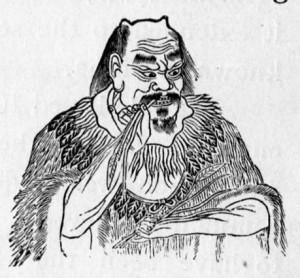A popular story about the origin of tea goes something like this:
In 2737 BCE (how on earth can anyone be that exact for prehistoric times) Emperor Shen Nong was reportedly boiling some water in a cauldron when a tea leaf blew into the pot of water. He tasted it and was blown away by the taste as well as the invigorating effects it had on his body.
Other renditions include: Shen Nong bathing when a tea leaf blew into his bath water, he tried it and the rest as they say, was history.
Then a more moderate version- which is more commonly retold in China has the story of Shen Nong experimenting with herbs and was poisoned. A tea leaf blew into his mouth and upon consuming, his illness was dispelled.
With such fanciful descriptions, it hardly comes as a surprise that most people dismiss this as plain mythology and often consider Chinese tea culture quaint and somewhat antiquated. Adding to the outlandishness of this claim is that it often is mentioned in tandem with the tale of Buddha cutting off his eyelids and tea leaves grew. By mere association with an outright tall tale, the credibility of Shen Nong plummets.
What do the ancient texts say?

“茶之饮,发乎神农”
Which simply means- the consumption of tea originated from Shen Nong- a far cry from Shen Nong boiling water in a cauldron and the rest of that tale.
In fact, it doesn’t take much of a scholar to dispel the reliability of that tale- if you add one single tea leaf- any tea leaf you can think of- to a teapot, can you discern much of the taste, if at all? Let alone the impact of a single leaf on an entire cauldron.
The bath story is worse- who drinks their own bath water? Furthermore even if Shen Nong is pretty heat resistant, the water temperature can’t be more than 50°C or 122°F, not even hot enough to infuse Gyokuro let alone a raw unprocessed tea leaf.
How the cauldron story probably originated is that Shen Nong is commonly credited as the first to discover boiling water had the effect of killing bacteria and germs. Hence story tellers in their own manner- ‘put two and two together’.
Now another ancient text that referenced Shen Nong is this:
‘神农尝百草以疗疾,一日遇七十二毒,得荼而解之’ - Taken from “Shen Nong’s Herbalism Manual” (神农本草)- author unknown
The text simply says: ‘Shen Nong experimented with hundreds of herbs in search of a remedy and was poisoned with 72 toxins that were cured by ‘Tu’ (an early form of the word 茶 which is of course tea).
Here we need to dabble a bit in semantics to make sense of this text. ‘Hundreds of herbs’ is not literal, it just means many and ’72 toxins’ doesn’t mean Shen Nong counted but it means a myriad of, often used to denote a quantity sufficiently large to imply ‘the whole kitchen sink’ so to speak.

First, this was 2700 BCE- there were no science labs for him to investigate the impact of asdearaerx compounds on the retardation of zxvqwae virus.
Secondly, Chinese herbalists in the past actually do experiment on the impact of herbs on themselves. This is not as ludicrous and haphazard as it seems because Chinese believe in ‘harmony’ and ‘yin and yang’. In short, where there is a toxin, a cure is found nearby.
It should be also be noted that at no point did the text mention that the tea leaves were boiled.
What we do know is that during the Spring Autumn era- in the Chronicles of Anzi it was mentioned that this Prime Minister ate tea leaves, cooked in the form of a broth. It may not have been a beverage by then, that was more likely in the Eastern Han.
*For more information on the history of tea, you can refer to this article*
Hence it was more likely than not that if the tale was true- it couldn’t have been the way it was commonly told, just a boring ol’ the emperor experimented with herbs and found one that work. Not that exciting and the stuff of happenstance and mystique but usually reality works that way.
Did Shen Nong actually exist?
With a name like Shen Nong or Divine Farmer, it is understandable that his existence was called into question. Throughout Chinese history (and many other civilizations as well), there was a penchant to deify emperors, especially in the early stages of civilization. While there were some tales that challenges the realms of believability, it was more likely that many of the innovations credited to him were actually discovered by people of his tribe, known as Shen Nong Shi.
As with word of mouth, the truth often gets distorted along the way, with each re-teller adding their unique spin to the story. With the passage of time, it is inevitable that the stories get increasingly fanciful- even today you can Google ‘Shen Nong tea’ and read all the versions for yourself.
My guess is that, it probably did happen but certainly not in the fashion that most western writings describe. The boring old truth was that this herbalist- who may or may not be the emperor- experimented with herbs and found one that worked.
How it eventually became a drink is a story for another post.
